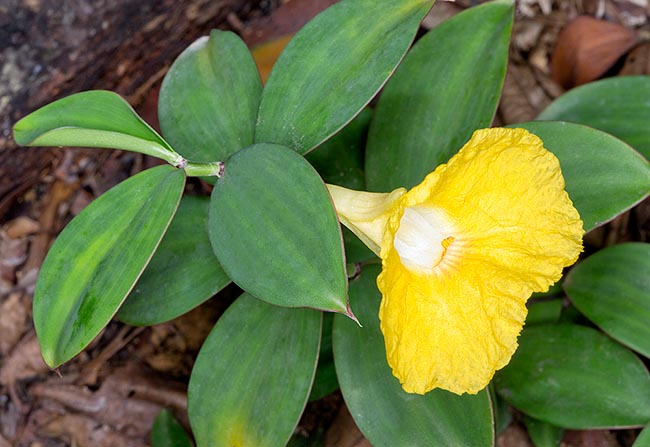Family : Costaceae

Text © Pietro Puccio

English translation by Mario Beltramini

Monocostus uniflorus is a rhizomatous perennial herbaceous plant, native to Peru, with even 60 cm tall tufts and luminous solitary flowers with an about 6 cm labellum. Easy cultivation in the Tropics in slightly shaded positions © Giuseppe Mazza
The species is native to Peru where it lives in the valley of the Huallaga River, between 500 and 800 m of altitude, in the underwood of the forest.
The generic name is the combination of the Greek adjective “μόνος” (mόnos) = unique and Costus, genus where was previously inserted and from which it differs because of the presence of only one flower per node; the specific name is the combination of the Latin adjective “unus, a, um” = single, and “flos, -oris” = flower, with obvious reference.
Common names: lemon ginger, yellow spiral ginger (English); caña de mico (Spanish).
The Monocostus uniflorus (Poepp. ex Petersen) Maas (1968) is a perennial rhizomatous herbaceous species, 40-60 cm tall, forming dense tufts with cylindrical stems spirally curved, of 0,6 cm of diameter, covered by the foliar sheaths of green colour often with brown-reddish shades. The leaves, spirally arranged, are simple, oblong-elliptic with entire margin and long pointed apex, 7-9 cm long and 2,5-3 cm broad, coriaceous, of glossy dark green colour with red edge. Solitary hermaphroditic flowers at the axil of the upper leaves, green tubular calyx, about 4 cm long, with three lobes with pointed apices, white-cream to pale yellow corolla, 6 cm long, with three 2,5 cm long lobes, greenish at the apex, obovate labellum with ruffled margin, 4-5 cm long and 5-6 cm broad, of lemon yellow colour with white centre streaked brown, and yellow petaloid stamen with curved apex. The fruits are bilocular flat capsules, 8 cm long and 1,5 cm broad, longitudinally dehiscent, containing several seeds, about 0,4 cm long, of glossy black colour.
It reproduces by seed in loam rich of organic substance with addition of sand or perlite per a 30%, maintained humid at the temperature of 24-26 °C, and easily by division ad portions of stem.
Particularly ornamental species due to the foliage and especially due to the flowers with the great and luminous labellum, cultivable in the tropical and subtropical humid regions, where it blooms almost continuously, and in the warm temperate ones, where temperatures close to the 0 °C are short lasting exceptions. Of easy cultivation, it requires a slightly shaded exposition, also some hours of sun in the morning, and well drained soils rich of organic substance maintained constantly humid, but without stagnations; useful are the fertilizations, in spring-summer, with balanced products with microelements. It well adapts to the cultivation in pot, with the same aforementioned modalities, for the decoration of greenhouses and luminous inner spaces, with night lowest temperatures in winter preferably not under the 15 °C and regular and abundant waterings in summer, more spaced in winter but without ever allowing the substratum to dry up completely.
Synonyms: Costus uniflorus Poepp. ex Petersen (1890); Dimerocostus uniflorus (Poepp. ex Petersen) K.Schum. (1904); Monocostus ulei K.Schum. (1904).
→ To appreciate the biodiversity within the COSTACEAE family please click here.
